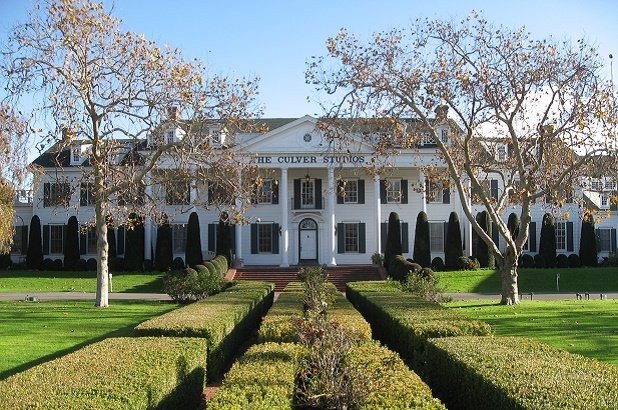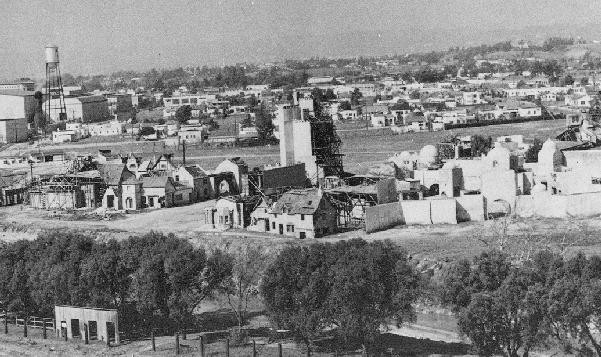The Culver Studios
Introduction
Text-to-speech Audio
Images
The mansion at Culver Studios today. Photo from The Wrap.

A photo of the mansion ca. 1920s/1930s from the Culver Studios website.

The studio in 1935, ran by David O'Selznick.

A sign for Desilu Productions with the mansion in the background.

An aerial shot of the Culver Studios from the 1930s.

Backstory and Context
Text-to-speech Audio
The Culver Studios were built in 1919 by Thomas H. Ince. Ince started his career in film by acting for the Biograph studio in New York. He began directing for the Independent Motion Picture Company before moving his family west and building his own studio: Inceville. Harry H. Culver, the founder of Culver City, heard about Ince and convinced him to build a studio in his town. Ince’s new studio included a grand entrance, four glass film stages, and a two-story administration building. This studio was named Triangle Studios and would later be bought by Metro-Goldywn-Mayer. Ince then finished his next studio, known today as the Culver Studios.
Ince only got to enjoy the success of his studios for a few years before his mysterious death in 1924. Director Cecil B. DeMille then took over the Culver Studios. DeMille had become fascinated with show business through his playwright father and went on to work in theatre himself. His cohorts Jesse L. Lasky and Samuel Goldfish (who would change his name to Goldwyn) persuaded DeMille into giving movies a try. In 1916, the Jesse L. Lasky Feature Play Company merged with a distribution company to become Paramount Pictures. When DeMille was squeezed out of Paramount, he struck out on his own. During his tenor at the Culver Studios, he built elaborate sets for The King of Kings. DeMille left to work for MGM in 1928, handing over the studios to Pathé America. That same year, Pathé merged with RKO, creating a new major studio.
RKO had only been in business a year when the Great Depression hit the United States. In the 1930s, they would declare bankruptcy. RKO spent most of its existence struggling to keep up with its main competitors. Without the funds to put big talent under contract, RKO often settled for working with independent production companies, like Walt Disney’s, and free-agents, like John Ford. They also leased the lots in Culver City, then-called the “back 40 [acres],” to producer David O. Selznick. There, Selznick would film the classic Gone With the Wind, burning down old sets for the invasion of Atlanta scene. Millionaire Howard Hughes took over RKO in 1950, and his poor leadership led to the demise of the company.
Desilu Productions, ran by the husband and wife team of Desi Arnaz and Lucille Ball, was the next to purchase the Culver Studios in 1956. Their focus was television rather than movies, leading to such hits as Lassie, Hogan’s Heroes, The Andy Griffith Show, and Star Trek. In 1967, Desilu sold all of its assets to Paramount Pictures, including the studios that had once been RKO’s. The studios in Culver City were renamed Paramount Culver Studios and were only used for a few years before being sold to Perfect Film & Chemical Company. In 1969, the studios were officially renamed The Culver City Studios.
The studio changed hands a few more times in the 1970s, and in 1976, the remaining sets from the old days were torn down. Laird International Studios bought the property in 1981 and used it as a rental lot. Grant Tinker and Garnett purchased it in the mid-1980s and undertook a $26 million renovation. The mansion and bungalows were restored, new television stages were built, and the old glass and muslin Stage 1 from 1918 was dismantled. Sony Pictures Entertainment bought the Culver Studios in 1991, around the same time they bought the MGM studios in Culver City. Then Studio City Los Angeles became the new owners in 2004. Today, the Culver City Studios are owned by an affiliate of Hackman Capital Partners and are used by multiple companies who lease the stages. Recently, Amazon Studios moved its production from Santa Monica to the Culver Studios, becoming part of one-hundred years of film history.
Sources
Thomas Ince. Sony Pictures Museum. Accessed March 05, 2018. http://www.sonypicturesmuseum.com/culver-city/ince.
Biography. Cecil B. DeMille. Accessed March 05, 2018. https://www.cecilbdemille.com/biography/.
Schrimer Encyclopaedia of Film: RKO Pictures. Encylopaedia.com. Accessed March 05, 2018. https://www.encyclopedia.com/arts/encyclopedias-almanacs-transcripts-and-maps/rko-radio-pictures.
Wanamaker, Marc. Memories Of A Visit To Culver City’s Famous "40-acres" Backlot In 1972. Culver City Historical Society. June 21, 2013. Accessed March 05, 2018. http://www.culvercityhistoricalsociety.org/articles/memories-of-a-visit-to-culver-citys-famous-40-acres-backlot-in-1972/.
About Us - Studio History. The Culver Studios. Accessed March 05, 2018. https://web.archive.org/web/20080325210850/http://www.theculverstudios.com:80/landing_pages/9,3.html.
The long-forgotten studio lot where almost 100 TV shows and movies were made. MeTV. March 25, 2016. Accessed March 05, 2018. https://metv.com/stories/the-long-forgotten-studio-lot-where-almost-100-TV-shows-and-movies-were-made.
Ng, David. Amazon Studios moving to Culver Studios in Culver City. Los Angeles Times. October 30, 2017. Accessed March 05, 2018. http://www.latimes.com/business/hollywood/la-fi-amazon-studios-culver-20171030-story.html.
Home. The Culver Studios. Accessed March 05, 2018. http://theculverstudios.com/. Photo source.
Cunningham, Todd. Culver Studios’ New Owners Plan Expansion, Not Condo Conversion. The Wrap. August 04, 2014. Accessed March 05, 2018. https://www.thewrap.com/culver-studios-gone-wind-shot-sold-85m/. Photo source.
Turnbull, Martin. Exterior view of Selznick International Pictures, Washington Blvd, Culver City, California, 1935. Martin Turnbull. March 03, 2015. Accessed March 05, 2018. https://martinturnbull.com/2015/03/03/exterior-view-of-selznick-international-pictures-washington-blvd-culver-city-california-1935/. Photo source.
RKO Forty Acres. Movie Locations Plus. Accessed March 05, 2018. http://www.movielocationsplus.com/rko40.htm. Photo source.
A Tour of the Thomas Ince Studios 1920. YouTube. January 24, 2013. Accessed March 05, 2018. https://www.youtube.com/watch?v=Y69jRBbmZjM. YouTube Video clip.
